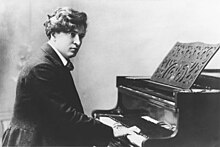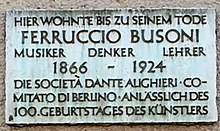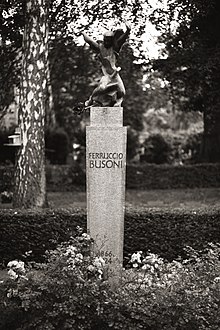Ferruccio Busoni
Ferruccio (Dante Michelangelo Benvenuto) Busoni (born April 1, 1866 in Empoli near Florence , † July 27, 1924 in Berlin ) was an Italian pianist , composer , conductor , librettist , essayist and music teacher . In addition to his own compositions, he transcribed and arranged numerous works by other composers. He has also published piano works by Johann Sebastian Bach and Franz Liszt . As a conductor, contemporary music was close to his heart.
Life
Ferruccio Busoni was the only child of an Italian clarinet virtuoso and a German-born pianist from Trieste . Ferruccio grew up bilingual. He received his first lessons from his parents, who drove his early career and marketed his performances. Busoni began composing piano pieces at the age of seven - the first eight works in the Busoni Directory (BV) were written between June and October 1873. In November 1873 he made his debut as a pianist in Trieste with pieces by Mozart , Schumann and Clementi . In 1875 he appeared for the first time as a soloist in a piano concerto (Mozart's 24th piano concerto ). From the age of 9 to 11 he studied at the Vienna Conservatory . He continued to compose diligently: in the four years 1875 to 1878 he composed the works BV 15 to BV 98, including the four-movement Concerto for Piano and String Quartet in D minor, Op. 17 (BV 80) in March 1878 . In 1881, at the age of 15, he became a member of the Accademia Filarmonica in Bologna .
From 1886 Busoni taught at the Leipzig Conservatory . From 1888 he was a piano teacher at the Conservatory in Helsinki , where he a patron and friend of Jean Sibelius was. In 1890/91 he stayed in Moscow . There he married Gerda Sjöstrand (1862–1956), the daughter of a Swedish sculptor. The marriage resulted in the two sons Benvenuto and Rafaello .
After another stop in Boston (1891 to 1894), Busoni settled in Berlin in 1894 . From 1910 he lived in Berlin-Schöneberg on the fifth floor of the Viktoria-Luise-Platz 11 building, where a plaque commemorates him. He remained an Italian citizen. Italy announced after signing the secret London agreement on 4 May 1915. Triple Alliance and took effect on 23 May 1915 on the side of the Entente in the First World War one. Busoni became an "enemy alien" and therefore moved to Zurich .
In 1920 he returned to Berlin from exile and moved back into his apartment on Viktoria-Luise-Platz. Here he had a library with 5000 books, including 53 volumes with works by ETA Hoffmann and 176 Cervantes volumes. Until his death he taught a master class in composition at the Berlin Academy of the Arts .
Due to the inflation from 1914 to 1923 , Busoni lost all of his financial fortune. His health suffered from long years of copious consumption of wine and cigars. He ignored a doctor's warning that he wanted to ban alcohol and nicotine. His friend Jakob Wassermann , who last met him in December 1922 when Busoni was 56 years old, remembered him as an old man with a "rumpled" face and snow-white hair. Impoverished and aged prematurely, Busoni died at the age of 58. His grave of honor in the Schöneberg III cemetery in Berlin-Friedenau (Dept. 6–56) was designed by Georg Kolbe .
plant
Characteristic
Busoni's early work shows the romantic background of composers such as Schumann , Chopin and Mendelssohn , later also Johannes Brahms , whom he initially met with respectful distance and whose F minor sonata he played in Vienna in 1884 in the presence of the critic Eduard Hanslick . The influence of the Handel Variations can be demonstrated in Busoni's early Chopin Variations op. 22 (BV 213); Brahms can also be heard in the concert piece op. 31 a (BV 236) from 1890, which Max Reger praised .
Unlike any other composer, however, Johann Sebastian Bach determined the pianistic and compositional-artistic development of Busoni, who later supervised the complete edition of his piano works at Breitkopf & Härtel and provided notes. The importance of Bach, who also worked on his own and other works, is evident in the contrapuntal structure of many compositions as well as in numerous transcriptions . The difficulty of some of the Bach arrangements is due to the high demands and sound ideas of Busoni, who wanted to raise the original compositions to the level of a virtuoso . His Fantasia contrappuntistica was seen as an attempt to “think through” Bach's work, which was probably conceived as a quadruple fugue, and to “forget” the piano in the process. Busoni replied to the criticism of his numerous changes, variants and extensions that he always considered the creative idea to be perfect, but not its musical or compositional implementation.
Already with his Elegien BV 249 , written between 1907 and 1909, a new beginning of his development is shown, which was interpreted by Busoni himself when he stated that he had put on his "very personal face" in them. With their expanded tonality and the bitonal approaches in places , they go beyond the usual functional harmonics of the time, just like the sonatinas , in which bitonal structures can also be found.
Compositions and arrangements (selection)
The works of Ferruccio Busoni were arranged thematically and chronologically in the Kindermann Directory (KiV), which is also called the Busoni Directory (BV).
Operas
- The choice of bride (1905; premiere: Hamburg 1912)
- Arlecchino or Die Fenster (Premiere: Zurich 1917)
- Turandot (WP: Zurich 1917)
- Doctor Faust , finished by Philipp Jarnach (premiere: Dresden 1925)
Instrumental music
- Chaconne in D minor, piano transcription of the 5th movement from Partita II for violin by Johann Sebastian Bach ( premiere : Budapest 1889)
- Concert piece for piano and orchestra op.31a (premiere: St. Petersburg 1890)
- Violin Concerto in D major op.35a (premiere: Berlin 1897)
- Sonata for violin and piano No. 2 op.36a
- Preludes op. 37
- Concerto for piano and orchestra with male choir op.39 (premiere: Berlin 1904)
- Fantasia contrappuntistica (composed in Dayton 1910) on the themes of the quadruple fugue from the art of fugue
- Berceuse élégiaque op.42 (premiere: New York 1911)
- Nocturne symphonique op.43 (premiere: Berlin 1914)
- Indian Fantasy for piano and orchestra op.44 (premiere: Berlin 1914)
- Two counterpoint studies after Johann Sebastian Bach (premier: 1917)
- Concertino for clarinet and small orchestra op.48 (premiere: Zurich 1918)
- Divertimento for flute and orchestra op.52 (premiere: Berlin 1921)
Fonts
Music theory writings
Busoni's music theory text Draft of a New Aesthetics of Tonal Art from 1907 contains reflections on new tone scales, sixth tone systems and first glimpses of the possibilities of electrically generated sounds. The publication of the revised version in 1916 sparked heated controversy. The conservative Wagner admirer Hans Pfitzner reacted in 1917 with his polemical work Futurists Danger .
-
Draft of a new aesthetic of music art , 1907. Critical online edition of the Humboldt University in Berlin.
- 2., extended edition 1916, dedicated to Rainer Maria Rilke . Insel-Verlag ( Insel-Bücherei , IB 202). Critical online edition of the Humboldt University in Berlin. Full text at Wikisource.
- Critical and annotated new edition, ed. by Martina Weindel, Wilhelmshaven 2001, ISBN 3-7959-0793-4 .
- New edition (after the 1916 edition) with notes by Arnold Schönberg and an afterword by Hans Heinz Stuckenschmidt , Suhrkamp Library, Frankfurt 1974, ISBN 3-518-01397-1 .
-
On the unity of music. Scattered records. First edition: Max Hesse, Berlin 1922 ( archive.org ).
- Martina Weindel (Ed.): Critical and commented new edition. Wilhelmshaven 2006, ISBN 3-7959-0871-X .
Letters
- Correspondence with Arnold Schönberg: Critical online edition of the Humboldt University in Berlin.
- Friedrich Schnapp (Ed.): Letters to his wife. Zurich 1935.
- English edition: Letters to his Wife. London 1938, New York 1975.
- Martina Weindel (ed.): Letters to his wife. 1889-1923. Annotated complete edition. 2 vols., Wilhelmshaven 2015, ISBN 978-3-7959-0991-8 (vol. 1) ISBN 978-3-7959-0993-2 (vol. 2).
- Martina Weindel (ed.): Letters to Henri, Katharina and Egon Petri. Wilhelmshaven 1999, ISBN 3-7959-0755-1 .
- Martina Weindel (ed.): Correspondence with Gottfried Galston. Wilhelmshaven 1999, ISBN 3-7959-0754-3 .
- Christiane Wassermann-Beirao (Ed.): Correspondence with José Vianna da Motta 1898–1921. Wilhelmshaven 2004, ISBN 3-7959-0833-7 .
- Martina Weindel (Ed.): Lettere ai genitori. [ Letters to Parents ], Rome 2006, ISBN 88-89675-01-2 .
Letters from Ferruccio Busoni are in the holdings of the Leipzig music publisher CF Peters in the Leipzig State Archives .
Pupil of Ferruccio Busoni
- Ernst Lochbrunner (1874–1923), pianist
- Giuseppe Becce (1877–1973) composer (~ 1906–?)
- Rudolph Ganz (1877–1972) composer, pianist, conductor (1899)
- Frieda Kindler (1879–1964) pianist
- Theodor Szántó (1877–1934) composer (1898–1901)
- Selim Palmgren (1878–1951) composer, pianist (1899–1901)
- Augusta Cottlow (1878–1954) pianist (1896–?)
- Etelka Freund (1879–1977) pianist (1898–?)
- Egon Petri (1881–1962) pianist
- Michael Zadora (1882–1946) pianist
- Percy Grainger (1882–1961) composer, pianist, conductor (late 1890s?)
- Magda von Hattingberg (= Magda Graedener; 1883–1959) pianist, writer; Hermann Graedener's wife
- Edgar Varèse (1883–1965) composer, conductor (1908–?)
- Louis Gruenberg (1884–1964) pianist, composer (1912–1919)
- Leo Sirota (1885–1965) pianist
- Alfred Hoehn (1887–1945) pianist
- Eduard Steuermann (1892–1964) composer, pianist (1911/12)
- Philipp Jarnach (1892–1982) composer, pianist, conductor (1914–?)
- Oskar Ziegler (1893–1962) pianist
- Svetislav Stančić (1895–1970) pianist (1918–1922)
- Wladimir Rudolfowitsch Vogel (1896–1984) composer (1918–1924?)
- Dimitri Mitropoulos (1896–1960) conductor, composer, pianist
- Erwin Bodky (1896–1958) pianist, composer
- Walther Geiser (1897–1993) composer, conductor (192? –1923)
- Luc Balmer (1898–1996) composer, conductor, pianist (1921/22)
- Herbert Behrens-Hangeler (1898–1981) painter, writer, musician
- Kurt Weill (1900–1950) composer (1921–1924)
- Otto Luening (1900–1996) composer
- Robert Blum (1900–1994) composer, conductor (1923)
- Stefan Wolpe (1902–1972) composer (1920)
- Paul Hoppe (1869–1933) composer
- Heinz Roemheld (1901–1985) composer
- Edward Weiss (vital dates not established) pianist (1917–1920)
- Verena Maurina-Press (1876–1969) pianist
- Leo Kestenberg (1882–1962) pianist, music teacher, cultural politician
Honors
- 1923: Honorary member of the International Society for Contemporary Music ISCM
- 1925: Sculpture by Georg Kolbe for Busoni's grave of honor in the Schöneberg III cemetery in Berlin-Friedenau.
- In 1927 a street in Berlin-Karow was named after Busoni, which still bears this name today.
- The Ferruccio Busoni International Piano Competition has been held in Bolzano every year since 1949 . The winners of the competition include Jörg Demus (1956), Martha Argerich (1957), Boris Bloch (1978) and Lilya Zilberstein (1987).
- In 1966, the Berlin committee of the Società Dante Alighieri donated the commemorative plaque on the building in Berlin-Schöneberg where Busoni last lived for the composer's 100th birthday.
- In 1988 Aribert Reimann donated the Busoni Composition Prize , which is awarded by the Berlin Academy of the Arts .
literature
chronologically:
- Hugo Leichtentritt : Ferruccio Busoni. Breitkopf & Härtel, Leipzig 1916 ( archive.org ).
- Gisella Selden-Goth: Ferruccio Busoni - the attempt at a portrait. Tal, Leipzig 1922.
- Ferdinand Pfohl : Busoni - personal memories of the person, the artist and friend. In: The music world. 1925, p. 156 ff.
- Edward J. Dent: Ferruccio Busoni: A Biography. Oxford University Press, London 1933.
- Helmut Wirth: Busoni, Ferruccio Benvenuto. In: New German Biography (NDB). Volume 3, Duncker & Humblot, Berlin 1957, ISBN 3-428-00184-2 , p. 70 f. ( Digitized version ).
- Gerda Busoni: Memories of Ferruccio Busoni Afas-Musik-Verlag, Berlin 1958.
- Ernst Hilmar : A style-critical examination of the works of Ferruccio Busoni from the years 1880–1890. Dissertation University of Graz 1962.
- Hans Heinz Stuckenschmidt : Ferruccio Busoni. Timeline of a European. Atlantis, Zurich 1967.
- Jürgen Kindermann: Thematic-chronological directory of the musical works of Ferruccio B. Busoni (= studies on the history of music of the 19th century. Volume 19). Gustav Bosse, Regensburg 1980, ISBN 3-7649-2033-5 .
- Antony Beaumont: Busoni the Composer. Indiana University Press, Bloomington 1985, ISBN 0-253-31270-1 .
- Larry Sitsky: Busoni and the Piano: The Works, the Writings, and the Recordings. Greenwood Press, New York / Westport, Conn./ London 1986, ISBN 0-313-23671-2 .
- Albrecht Riethmüller: Ferruccio Busoni's Poetics (= New Studies in Musicology. Volume 4). Mainz 1988, ISBN 3-7957-1723-X .
- Marc-André Roberge: Ferruccio Busoni: A Bio-Bibliography. Greenwood Press, New York / Westport, Conn./ London 1991, ISBN 0-313-25587-3 .
- Joseph Willimann: The correspondence between Ferruccio Busoni and Volkmar Andreae, 1907–1923 . - Verlag Hug & Co, Zurich 1994. - ( New Year's Gazette of the Allgemeine Musikgesellschaft Zürich , 178), therein pp. 14-16 also about the relationship between Busoni and Othmar Schoeck .
- Reinhard Ermen: Ferruccio Busoni (= Rowohlt's monographs. 483). Rowohlt, Reinbek near Hamburg 1996, ISBN 3-499-50483-9 .
- Martina Weindel: Ferruccio Busoni's aesthetics in his letters and writings (= publications on music research. Volume 18). Wilhelmshaven 1996, ISBN 3-7959-0692-X .
- Martina Weindel (ed.), Gottfried Galston: Calendar notes about Ferruccio Busoni. Wilhelmshaven 2000, ISBN 3-7959-0792-6 .
- Martina Weindel, Hyesu Shin, Albrecht Riethmüller: Busoni, Ferruccio. In: Ludwig Finscher (Hrsg.): The music in past and present . Second edition, personal section, volume 3 (Bjelinski - Calzabigi). Bärenreiter / Metzler, Kassel et al. 2000, ISBN 3-7618-1113-6 ( online edition , subscription required for full access)
- Uwe Harten : Busoni, Ferruccio. In: Oesterreichisches Musiklexikon . Online edition, Vienna 2002 ff., ISBN 3-7001-3077-5 ; Print edition: Volume 1, Verlag der Österreichischen Akademie der Wissenschaften, Vienna 2002, ISBN 3-7001-3043-0 .
- Gottfried Galston: Busoni. Gli ultimate mesi di vita. Diario di Gottfried Galston. a cura di Martina Weindel, Roma 2004, ISBN 88-900999-2-5 .
- Albrecht Riethmüller , Hyesu Shin (ed.): Busoni in Berlin. Facets of a cosmopolitan composer. Wiesbaden 2004, ISBN 3-515-08603-X .
- Eva Hanau (Ed.): Ferruccio Busoni in correspondence with his publisher Breitkopf & Härtel. 2 volumes, Wiesbaden 2012, ISBN 978-3-7651-0318-6 .
- Busoni. Freedom for the art of music! Publication for the exhibition of the Berlin State Library - Prussian Cultural Heritage, the Art Library - Berlin State Museums and the State Institute for Music Research, September 4, 2016 - January 8, 2017, Kulturforum. Published on behalf of the Prussian Cultural Heritage Foundation. Bärenreiter, Kassel 2016, ISBN 978-3-7618-2436-8 .
Web links
- Literature by and about Ferruccio Busoni in the catalog of the German National Library
- Works by and about Ferruccio Busoni in the German Digital Library
- Newspaper article about Ferruccio Busoni in the press kit of the 20th century of the ZBW - Leibniz Information Center for Economics .
- Sheet music and audio files by Busoni in the International Music Score Library Project
- Literature on Ferruccio Busoni in the bibliography of music literature
- Ferruccio Busoni - Letters and Writings : Critical Online Edition of the Humboldt University of Berlin
- www.kreusch-sheet-music.net - Sheet music from Ferruccio Busoni in the public domain
- Busoni's catalog of works based on the Kindermann catalog , including references to the corresponding audio recordings (in English)
- Works by Ferruccio Busoni at Zeno.org .
- Exhibition of the Berlin State Library for Busoni's 150th birthday
Individual evidence
- ↑ The thesis of the alleged existence of an older twin brother named Federico Busoni is based on an April Fool's joke in connection with a radio broadcast on the occasion of Ferruccio Busoni's 150th birthday (Deutschlandfunk, Kultur heute on April 1, 2016 5:47 pm. Title of the article: Der missing twin brothers).
- ^ Edward J. Dent: Ferruccio Busoni: A Biography. Oxford University Press, London 1933, p. 17.
- ^ Antony Beaumont: Busoni, Ferruccio. In: Grove Music Online (English; subscription required).
- ↑ Michael Horst: Pianist and composer, thinker and teacher: In the footsteps of Ferruccio Busoni concerti.de, August 17, 2011.
- ^ Ferruccio Busoni and the Berliner Philharmoniker berliner-philharmoniker.de, 2016.
- ↑ a b slave of instincts . In: Der Spiegel . No. 49 , 1967, p. 190-193 ( online ).
- ↑ a b Helmut Wirth: Busoni, Ferruccio Benvenuto. In: Friedrich Blume (Hrsg.): The music in past and present (MGG). First edition, Volume 2 (Boccherini - Da Ponte). Bärenreiter / Metzler, Kassel et al. 1952, DNB 550439609 , Sp. 520-527
- ↑ Reinhard Ermen: Ferruccio Busoni . Rowohlt, Reinbek near Hamburg 1996, p. 40.
- ^ Hermann Grabner : General music theory. 24th edition. Bärenreiter, Kassel 2008, ISBN 978-3-7618-0061-4 , p. 141.
- ^ ISCM Honorary Members
| personal data | |
|---|---|
| SURNAME | Busoni, Ferruccio |
| ALTERNATIVE NAMES | Busoni, Ferruccio Dante Michelangelo Benvenuto (full name) |
| BRIEF DESCRIPTION | Italian pianist, composer, conductor and music teacher |
| DATE OF BIRTH | April 1, 1866 |
| PLACE OF BIRTH | Empoli , metropolitan city of Florence |
| DATE OF DEATH | July 27, 1924 |
| Place of death | Berlin |





